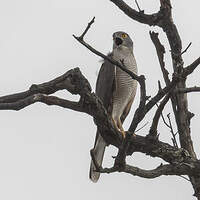African Goshawk
Aerospiza tachiro - Autour tachiro
Identification
The African Goshawk is a relatively large African hawk, the largest next to the Black Hawk. Its plumage is very variable, even within a single subspecies, with variations mainly in the background colour and the extension and colour of the bars on the lower parts. This species displays the pronounced sexual dimorphism found in Accipiter. The female is a third bigger than the male.
Typically, the adult male has steel-grey upperparts and finely barred underparts in grey-brown, reddish-brown and even bright red against a white or reddish background. Its eyes are yellow, the cere on its beak is not bright yellow as in other hawks, but yellow-green, yellowish or even grey-green. The tail is dark grey with some distant pale grey bars and sometimes white in the centre. The legs are yellow. Some males have russet or red flanks, with no stripes.
The female has dark brown upperparts and its underparts are heavily barred in brown against a white background. Its cere is the same as the male's.
The immature bird resembles the female, but its underside, instead of being barred, is heavily speckled with brown on a pale background, and the eyes are brown.
There is a melanistic, entirely dark form of this species with pale bars on the upper tail and in flight contrasts between its pale primary remiges and dark coverts.
The race pembaensis is smaller, pale grey above and reddish or rosy-red underneath.
Subspecific information 4 subspecies
- Aerospiza tachiro tachiro (s Angola to Mozambique and South Africa)
- Aerospiza tachiro unduliventer (Eritrea, Ethiopia)
- Aerospiza tachiro sparsimfasciata ()
- Aerospiza tachiro pembaensis (Pemba I.. off Tanzania.)
Foreign names
- Autour tachiro,
- Azor tachiro,
- açor-africano,
- Afrikahabicht,
- afrikai karvaly,
- Afrikaanse Havik,
- Astore africano,
- afrikansk duvhök,
- Bantuhauk,
- jastrab tachiro,
- jestřáb tachiro,
- Sorthvid Duehøg,
- afrikanlintuhaukka,
- Afrikaanse Sperwer,
- astor tatxiro,
- krogulec trzypręgowy,
- Африканский тетеревятник,
- アフリカオオタカ,
- 非洲鹰,
- bantuhök,
- 非洲鷹,
Voice song and call
Habitat
Behaviour character trait
The African Goshawk, like other hawks, hunts by waiting and hiding in dense vegetation. It often stays still throughout the day, preferring to hunt at dawn and sunset. It can hunt by circling above the canopy, and even by making short pursuits through the undergrowth. At the time of the mating display, it performs long circular flights at a high altitude above the forest it occupies.
Dietfeeding habits
Reproduction nesting
Geographic range
The African Goshawk is present in East Africa, from Southern Somalia and Uganda to the north, down to the Cape in the south, along the coast. At the latitude of Mozambique, its range expands westward to cover the entirety of Zambia and Zimbabwe, a large part of Angola and the south of the Democratic Republic of Congo.
Threats - protection
IUCN conservation status
concern
in the Wild
threatened
evaluated
The African Goshawk, which knows how to adapt to any forest environment, including secondary forests and plantations, is one of the most common hawks in African forests. Therefore, the species, which does not seem to be affected by pesticides, is not currently facing global threats. However, an acceleration of deforestation would of course represent a real threat.
Sources of information
- IOC World Bird List (v14.2), Gill, F and D Donsker (Eds). 2024-04-18.
- Birds of East Africa: Kenya, Tanzania, Uganda, Rwanda, Burundi, Terry Stevenson, John Fanshawe
- HBW Alive,
- IUCN Red List of Threatened species,
- Global Raptor Information Network,
Other sources of interest
 Specification sheet created on
31/07/2023 by Catherine et Bernard Lanneluc
Specification sheet created on
31/07/2023 by Catherine et Bernard LannelucTranslation by AI Oiseaux.net
© 1996-2025 Oiseaux.net
- Accipitriformes
- Aegotheliformes
- Anseriformes
- Apodiformes
- Apterygiformes
- Bucerotiformes
- Caprimulgiformes
- Cariamiformes
- Casuariiformes
- Charadriiformes
- Ciconiiformes
- Coliiformes
- Columbiformes
- Coraciiformes
- Cuculiformes
- Eurypygiformes
- Falconiformes
- Galliformes
- Gaviiformes
- Gruiformes
- Leptosomiformes
- Mesitornithiformes
- Musophagiformes
- Nyctibiiformes
- Opisthocomiformes
- Otidiformes
- Passeriformes
- Pelecaniformes
- Phaethontiformes
- Phoenicopteriformes
- Piciformes
- Podargiformes
- Podicipediformes
- Procellariiformes
- Psittaciformes
- Pterocliformes
- Rheiformes
- Sphenisciformes
- Steatornithiformes
- Strigiformes
- Struthioniformes
- Suliformes
- Tinamiformes
- Trogoniformes


























